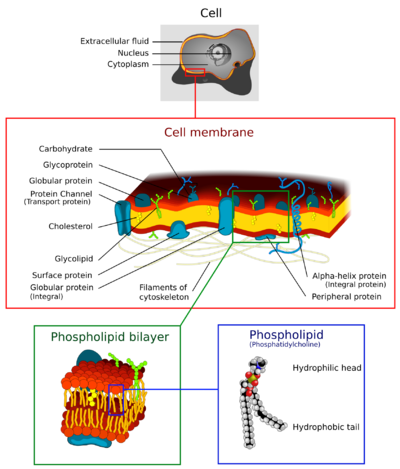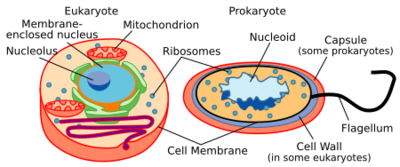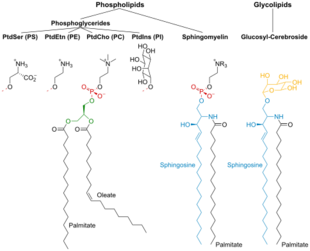Cell membrane facts for kids

The cell membrane, also called the plasma membrane, is the outer layer that surrounds every living cell. Think of it as the cell's skin. It separates the inside of the cell from the outside world, protecting it and giving it shape.
This important barrier is made of a special double layer of fats called a lipid bilayer. Embedded in this layer are proteins that act like doors and windows, controlling what goes in and out. The cell membrane is a gatekeeper, carefully choosing which substances can pass through. This is called being selectively permeable. Cell membranes are also involved in many other jobs, like helping cells stick together and communicate with each other.
Contents
The Discovery of the Cell Membrane
When Robert Hooke first discovered cells in 1665, scientists could only see the thick cell walls of plant cells. For a long time, they didn't realize that animal cells, and even plant cells under their walls, had a thin, flexible membrane. In 1895, Ernest Overton suggested that this membrane was made of fats, or lipids.
Later, in 1925, two scientists named Gorter and Grendel did an experiment with red blood cells. They discovered that there were enough lipids to wrap around the cell twice. This led to the idea of a lipid bilayer, or a double layer of fats.
The model we use today is called the fluid mosaic model. It was developed by S. J. Singer and G. L. Nicolson in 1972. This model describes the cell membrane as a flexible, fluid surface with many different proteins floating in it, like tiles in a mosaic.
What Is the Cell Membrane Made Of?
Cell membranes are made of three main types of molecules: lipids, proteins, and carbohydrates.
Lipids: The Main Fabric
The main building blocks of the cell membrane are special lipids called phospholipids. Each phospholipid molecule has:
- A head that loves water (hydrophilic).
- Two tails that hate water (hydrophobic).
Because the inside and outside of a cell are watery, the phospholipids arrange themselves into a double layer called the lipid bilayer. The water-loving heads face outwards, towards the water, and the water-hating tails hide in the middle, away from the water. This structure creates a strong but flexible barrier.
Another important lipid is cholesterol. It is tucked between the phospholipids and helps keep the membrane from becoming too stiff or too runny, especially when temperatures change.
Proteins: The Workers of the Membrane
| Type | Description | Examples |
| Integral proteins | These proteins go all the way through the membrane. They often act as channels or tunnels to let things pass through. | Ion channels, protein pumps |
| Peripheral proteins | These proteins are attached to the surface of the membrane, either on the inside or the outside. They often help with cell communication or chemical reactions. | Some enzymes and hormones |
Proteins make up about half of the cell membrane. They have many important jobs:
- Transport: They act as channels or pumps to move materials across the membrane.
- Communication: Some proteins are receptors that receive signals from other cells.
- Structure: They can attach to the cell's internal skeleton to help the cell keep its shape.
Carbohydrates: The Cell's ID Tags
Carbohydrates are sugar chains attached to proteins (forming glycoproteins) or lipids (forming glycolipids) on the outside surface of the cell membrane. They act like identification tags that help cells recognize each other. This is important for the immune system to tell the difference between your own cells and invading germs.
What Does the Cell Membrane Do?
The cell membrane is more than just a container. It has several vital jobs that keep the cell alive and working properly.
Controlling What Enters and Exits
The membrane is selectively permeable, meaning it acts like a gatekeeper. It lets some things in easily, while others need special permission or are blocked completely. This movement happens in a few ways:
Passive Transport
This is the easiest way for substances to cross the membrane, and it doesn't require any energy from the cell.
- Diffusion: Small molecules like oxygen and carbon dioxide can slip directly through the lipid bilayer. They naturally move from an area where there are a lot of them (high concentration) to an area where there are fewer (low concentration).
- Osmosis: This is the special name for the diffusion of water across a membrane.
- Facilitated Diffusion: Some molecules, like sugar, are too big to slip through. They need help from protein channels that act like special tunnels to get them across.
Active Transport
Sometimes a cell needs to move something from a low concentration to a high concentration—the opposite of diffusion. This is like pushing something uphill. It requires energy from the cell. Special protein pumps in the membrane do this work.
Vesicle Transport
For very large particles, the cell uses a different method.
- Endocytosis: The cell membrane wraps around a particle from the outside and pinches off to form a small bubble, or vesicle, inside the cell. This is how cells "eat."
- Exocytosis: A vesicle from inside the cell moves to the membrane, merges with it, and releases its contents to the outside. This is how cells get rid of waste or send out important molecules like hormones.
Cell Communication and Shape
The membrane also helps cells talk to each other. Receptor proteins on the surface catch chemical signals from other cells. The membrane also attaches to the cytoskeleton, an internal network of protein fibers that helps the cell maintain its shape.
Membranes in Simple Cells
Prokaryotes, like bacteria, are simpler cells but they also have a cell membrane. In addition to the membrane, most bacteria are also surrounded by a tough, protective cell wall.
Some bacteria, known as gram-negative bacteria, have two membranes: an inner plasma membrane and an outer membrane, with a space in between. This extra outer layer provides even more protection.
Special Structures of the Membrane
The Fluid Mosaic Model
The best way to picture the cell membrane is using the fluid mosaic model. It describes the membrane as a "sea" of lipids that are constantly moving and shifting. Floating in this sea are various proteins, like boats or icebergs. This fluid nature allows the cell to be flexible and change its shape.
The Cytoskeleton
The cytoskeleton is a network of protein fibers inside the cell. It acts like the cell's skeleton, providing shape and support. It connects to proteins in the cell membrane, anchoring them in place and helping the cell move. Some cells have finger-like extensions called microvilli that increase their surface area, which is useful for absorbing nutrients. These are supported by the cytoskeleton.
Membranes Inside the Cell
Many structures inside eukaryotic cells, called organelles, also have their own membranes.
- The nuclear membrane surrounds the nucleus, protecting the cell's DNA.
- The endoplasmic reticulum and Golgi apparatus are membrane-bound organelles that help make and transport proteins and lipids.
- Mitochondria, the cell's power plants, have two membranes.
Different Types of Cell Membranes
While all cell membranes share the same basic structure, they can be specialized for different jobs in different cells.
- Sarcolemma: This is the special name for the cell membrane of a muscle cell. It is strong and helps transmit the signals that make muscles contract.
- Oolemma: This is the membrane of an oocyte (an egg cell). It plays a key role in fertilization.
- Axolemma: This is the membrane that covers the long fibers of nerve cells called axons. It is essential for sending nerve signals quickly through the body.
See also
 In Spanish: Membrana plasmática para niños
In Spanish: Membrana plasmática para niños
- Artificial cell
- Bacterial cell structure
- Cell theory
- Elasticity of cell membranes
- Gram-positive bacteria
- History of cell membrane theory
- Lipid raft





